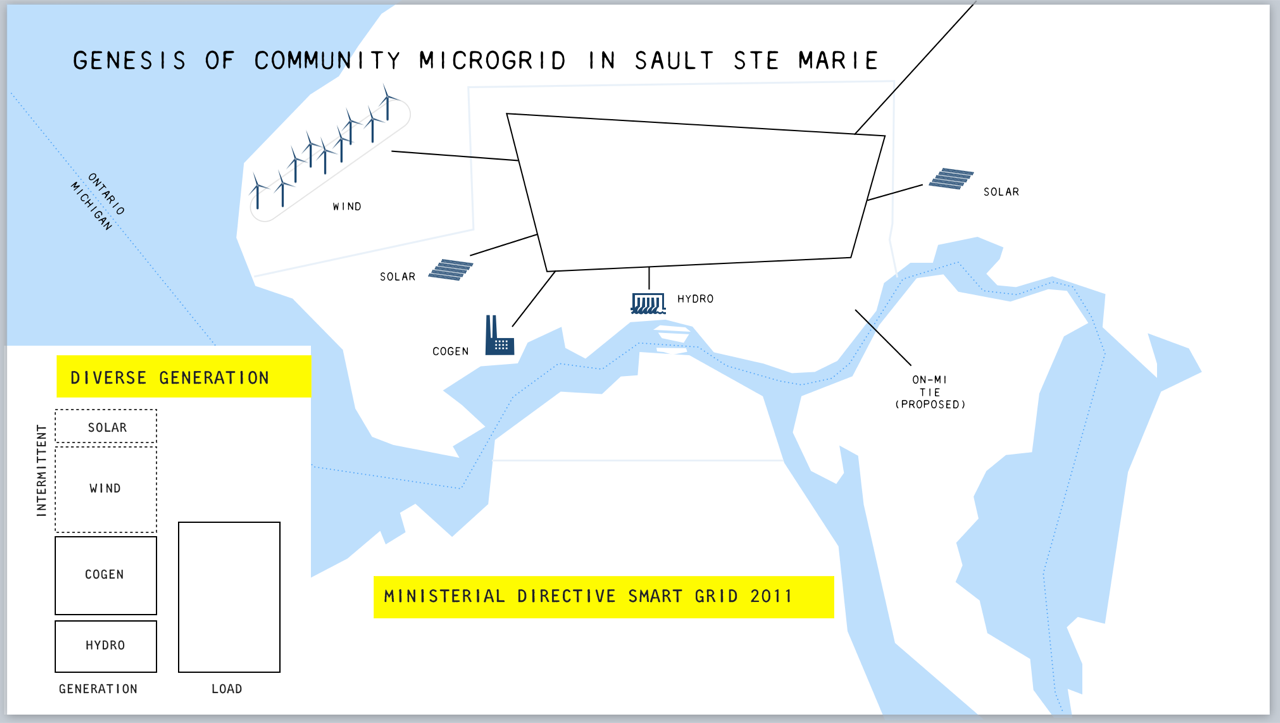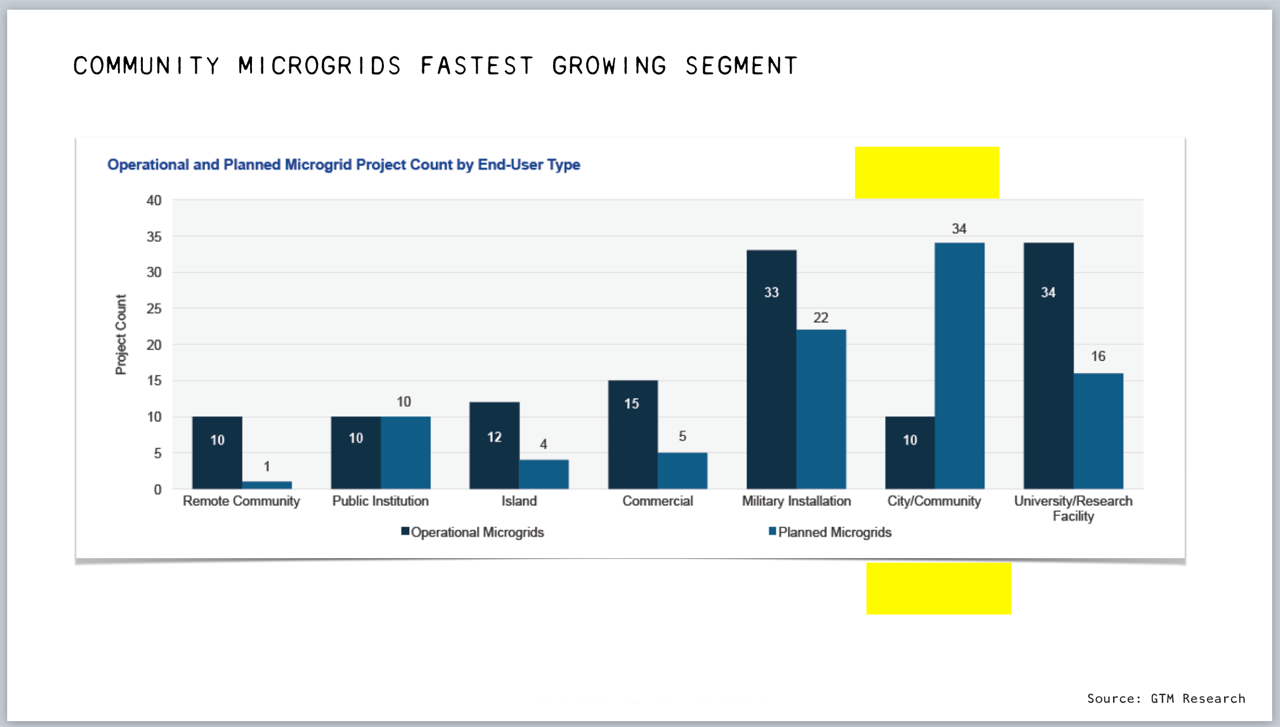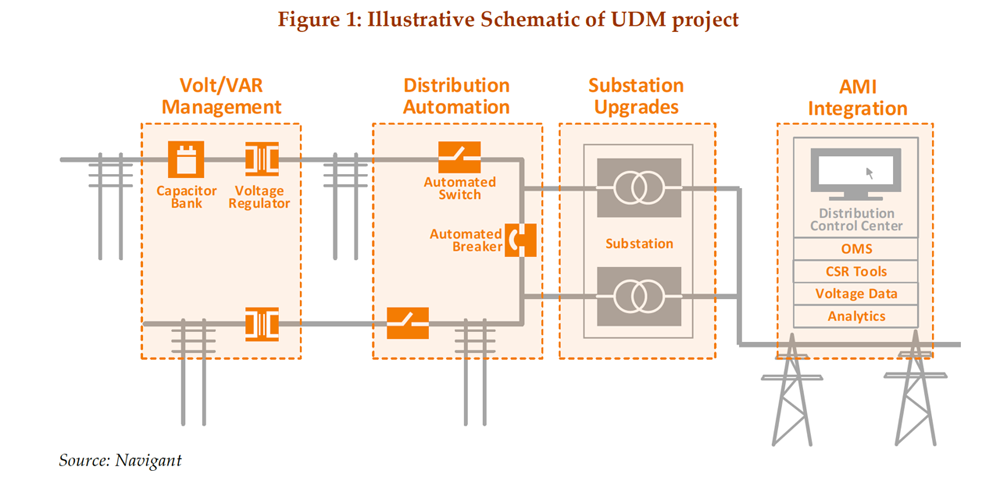Sault Ste. Marie may soon become known as a leading example in the field of electricity distribution infrastructure. The relatively small industrial town is pioneering microgrid development in a way that is drawing international attention and positioning itself as a proving ground for some of the most promising new and innovative energy technologies available in the market. While hosting an entire eco-system of local energy companies, the town seems to have rallied behind community-scale microgrid development mobilizing almost a billion dollars in project capital for export-oriented clean power development led by the firm Infrastructure Energy.
Glen Martin, the Founder and CEO of California-based Infrastructure Energy (IE), originally based in Los Angeles, opened Canadian operations in Ontario in 2013 to focus on the development of the firm’s first microgrid project. “Ontario has become an attractive location for early advances in microgrid development,” he says, comments that no doubt please Ontario policy makers who have been trying to encourage energy technology development based in the province.
 The IE microgrid project in Sault Ste. Marie called “The Sault Microgrid” anticipates achieving scale in the near future and installing a range of facilities including distributed generation, voltage optimization, distribution automation, and smart grid control systems, all co-ordinated closely with the local distribution company (“LDC”). The peak load of PUC Distribution Inc., the LDC in Sault Ste. Marie, is roughly 150MW in winter, and 90 MW in summer. The Sault Microgrid project was designed to cover 100% of the community, and is scheduled to begin operating in 2018.
The IE microgrid project in Sault Ste. Marie called “The Sault Microgrid” anticipates achieving scale in the near future and installing a range of facilities including distributed generation, voltage optimization, distribution automation, and smart grid control systems, all co-ordinated closely with the local distribution company (“LDC”). The peak load of PUC Distribution Inc., the LDC in Sault Ste. Marie, is roughly 150MW in winter, and 90 MW in summer. The Sault Microgrid project was designed to cover 100% of the community, and is scheduled to begin operating in 2018.
The project is financed by the “North American Grid Modernization Fund,” a project investment fund focused on community scale microgrids in North America. The platform’s high level objectives are to achieve efficiency, reliability and resiliency for the electricity customers in communities where IE develops projects. At a technical level the microgrid is designed to provide a platform for integration of a number of distributed energy resources (DER), including distribution tied solar photovoltaics, micro-wind, CHP/district energy, waste-to-energy, industrial co-generation, energy storage and electric vehicles.
 At the same time, the microgrid project has enjoyed the active support of the local community and entrepreneurs since inception. For a number of years the town and a variety of local businesses have been developing and promoting a local energy strategy. Known as “Sault Ste. Marie’s Smart Energy Strategy,” it was led by the Sault Ste. Marie Innovation Centre (“SSMIC”) and the Sault Ste. Marie Economic Development Corporation (“SSMEDC”). The related community based work has many parts and players in the energy ecosystem the community has nurtured over the last decade. For further information on the existing range of local energy initiatives in Sault Ste. Marie, see “Sault Ste. Marie builds its future with energy projects” from IPPSO FACTO, June 2014.
At the same time, the microgrid project has enjoyed the active support of the local community and entrepreneurs since inception. For a number of years the town and a variety of local businesses have been developing and promoting a local energy strategy. Known as “Sault Ste. Marie’s Smart Energy Strategy,” it was led by the Sault Ste. Marie Innovation Centre (“SSMIC”) and the Sault Ste. Marie Economic Development Corporation (“SSMEDC”). The related community based work has many parts and players in the energy ecosystem the community has nurtured over the last decade. For further information on the existing range of local energy initiatives in Sault Ste. Marie, see “Sault Ste. Marie builds its future with energy projects” from IPPSO FACTO, June 2014.
Many aspects of the microgrid project represent opportunities to deploy technologies that have been proven but not yet widely deployed. As a result The Sault Microgrid may act as a centre for demonstrating a wide range of key advances, some of which are likely to be interesting not only in themselves, but also in terms of how they interact with each other. The synergies between different components of a diversified and integrated microgrid represent some of the most promising areas for technical innovation.
The initiatives are likely to be seen as ground-breaking in Canada and internationally. Examples of areas in which The Sault Microgrid is on the leading edge include distribution automation (DA) systems; Voltage/VAR management (VVM) systems; and integration and enhancement of the existing Advanced Metering Infrastructure (AMI).
 Mr. Martin highlights the anticipation of “Broadly felt benefits in efficiency, reliability and resilience delivered by an integrated microgrid project at a scale never before delivered in North America.” The initiative is assisting with the establishment of an Energy Network Operations Centre (“ENOC”) within a Smart Cities focused incubator called the Centre of Energy Excellence for Northern Climates (“CENEX_North”). At the same time he notes that the project is encouraging “the evolution of the LDC business model by providing a platform for creation of an Energy Services Utility offering services directly to industrial, commercial and residential customers.” The investment is being facilitated through a Private-Public-Partnership (“P3”) financing model, to minimize risk and costs to electricity customers. The entire project is designed to have ‘bill neutral’ impact to rate-payers.
Mr. Martin highlights the anticipation of “Broadly felt benefits in efficiency, reliability and resilience delivered by an integrated microgrid project at a scale never before delivered in North America.” The initiative is assisting with the establishment of an Energy Network Operations Centre (“ENOC”) within a Smart Cities focused incubator called the Centre of Energy Excellence for Northern Climates (“CENEX_North”). At the same time he notes that the project is encouraging “the evolution of the LDC business model by providing a platform for creation of an Energy Services Utility offering services directly to industrial, commercial and residential customers.” The investment is being facilitated through a Private-Public-Partnership (“P3”) financing model, to minimize risk and costs to electricity customers. The entire project is designed to have ‘bill neutral’ impact to rate-payers.
The Sault Microgrid has already found a receptive audience at the federal level. The Smart Grid Deployment and Demonstration Program recently developed by the federal government appears to be a good fit with many aspects of the initiative.
 Ontario Premier Kathleen Wynne in 2015 with Los Angeles Mayor Eric Garcetti, Dr. Ilse Treurnicht, CEO of MaRS, and Fred Walti, CEO, Los Angeles Cleantech Incubator (LACI).
Ontario Premier Kathleen Wynne spoke about The Sault Microgrid and Infrastructure Energy as examples of the benefits of international collaboration, when a formal collaboration agreement between Ontario-based MaRS and California based Los Angeles Cleantech Incubator (“LACI”) was announced in 2015. (See photo.)
Ontario Premier Kathleen Wynne in 2015 with Los Angeles Mayor Eric Garcetti, Dr. Ilse Treurnicht, CEO of MaRS, and Fred Walti, CEO, Los Angeles Cleantech Incubator (LACI).
Ontario Premier Kathleen Wynne spoke about The Sault Microgrid and Infrastructure Energy as examples of the benefits of international collaboration, when a formal collaboration agreement between Ontario-based MaRS and California based Los Angeles Cleantech Incubator (“LACI”) was announced in 2015. (See photo.)
Martin noted at the time that “IE’s mission is to help cities accelerate the transition to the future. I am delighted that the formation of the North American Grid Modernization Fund will provide IE access not only to the capital it needs to support that mission, but also to the exceptional capabilities of the Stonepeak team.”
PUC Inc. is a private company registered under the Ontario Business Corporations Act and is wholly owned by the Corporation of the City of Sault Ste. Marie. PUC Inc. has one subsidiary: PUC Distribution Inc. PUC Distribution Inc. distributes electricity to residences and businesses within the boundaries of the City of Sault Ste. Marie as well as parts of neighbouring towns. PUC Distribution Inc. is a provincially regulated Local Distribution Company (LDC).
Infrastructure Energy assists public and investor-owned energy utilities with the design, build, operation and financing of complex power grid modernization projects. Its community-scale microgrid and related projects “enable the large-scale integration of distributed generation and storage assets, such as wind, biomass, solar PV, and electric vehicles (EVs), and help cities and utilities deliver clean, reliable and climate-resilient power.” Infrastructure Energy’s project development process includes cost/benefit analysis, regulatory and contractual support, selection of technology partners, public-private project financing, and customer engagement support.
Previously known as Energizing Co, IE has developed a working relationship with investment firm Stonepeak Infrastructure Partners (“Stonepeak”) with whom it created the new investment platform, the North American Grid Modernization Fund (“NAGMF”), focused on community-scale microgrids and grid modernization investments. The fund provides project equity that can be leveraged with project debt to provide more than $1 billion in total project investment into the IE pipeline.
See also “Sault gets 7MW storage for grid support,” elsewhere in this issue of IPPSO FACTO.
